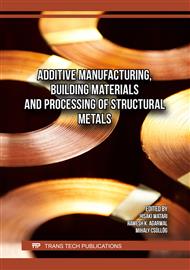[1]
Kozłowski and Kadela M.: Mechanical Characterization of Lightweight Foamed Concrete. Advances in Materials Science and Engineering,(2018), pp.1-8.
DOI: 10.1155/2018/6801258
Google Scholar
[2]
Yew et al.: Effect of Pre-Soaking Treatment Method of Plant-Based Aggregate on the Properties of Lightweight Concrete—Preliminary Study. Coatings, 13(5), (2021), p.864.
DOI: 10.3390/coatings13050864
Google Scholar
[3]
Loh et al.: Mechanical and thermal properties of synthetic polypropylene fiber0reinforced renewable oil palm shell lightweight concrete. Materials, 14(9), (2021), p.2337.
DOI: 10.3390/ma14092337
Google Scholar
[4]
Yong et al.: Strength properties of renewable bio-based lightweight foam concrete incorporating of polypropylene fibre, E3S Web Conf, (2022), p.347.
DOI: 10.1051/e3sconf/202234702003
Google Scholar
[5]
Agrawal et al.: A Comprehensive Review on the Performance of Structural Lightweight Aggregate Concrete for Sustainable Construction. Construction Materials, 1,(2021), pp.39-62.
DOI: 10.3390/constrmater1010003
Google Scholar
[6]
Yew et al.: Performance of surface modification on bio-based aggregate for high strength lightweight concrete. Case Studies in Construction Materials, 16, (2022), p. e00910.
DOI: 10.1016/j.cscm.2022.e00910
Google Scholar
[7]
Yew et al.: Mechanical properties of barchip polypropylene fibre-reinforced lightweight concrete made with recycled crushed lightweight expanded clay aggregate, Frontiers in Materials, 8, (2021), p.753619.
DOI: 10.3389/fmats.2021.753619
Google Scholar
[8]
Turatsinze A & Garros M. On the modulus of elasticity and strain capacity of self-compacting concrete incorporating rubber aggregates. Resources, Conservation and Recycling, 52(10), (2008), pp.1209-1215.
DOI: 10.1016/j.resconrec.2008.06.012
Google Scholar
[9]
Shafigh et al.: Effect of steel fibre on the mechanical properties of oil palm shell lightweight concrete. Materials & Design, 32, (2011), pp.3926-3932.
DOI: 10.1016/j.matdes.2011.02.055
Google Scholar
[10]
Yew et al.: Influence of high-performance polypropylene fibre and heat-treated dura oil palm shell on durability properties of lightweight concrete. European Journal of Environmental and Civil Engineering, 24(14), (2020), pp.2469-2488.
DOI: 10.1080/19648189.2018.1509022
Google Scholar
[11]
Yew et al.: New mixing method of self-consolidating concrete incorporating of silica fume. Advances in Material Science and Engineering, (2021), pp.265-272.
DOI: 10.1007/978-981-16-3641-7_31
Google Scholar
[12]
Lee et al.: Effect of ceramic dust as partial replacement of cement on lightweight foamed concrete. International Journal of Integrated Engineering, 13(4), (2021), pp.304-312.
Google Scholar
[13]
Yim et al.: Method for evaluating segregation in self-consolidating concrete using electrical resistivity measurements. Construction and Building materials, 232, (2020), p.117283.
DOI: 10.1016/j.conbuildmat.2019.117283
Google Scholar
[14]
Yew et al.: Effect of pre-soaking treatment method of plant-based aggregate on the properties of lightweight concrete-preliminary study. Coatings, 13(5), (2023), p.864.
DOI: 10.3390/coatings13050864
Google Scholar
[15]
Yong et al.: Utilizing bio-based and industrial waste aggregates to improve mechanical properties and thermal insulation in lightweight foamed macro polypropylene fibre-reinforced concrete, Journal of Building Engineering, 91, (2024), p.109588.
DOI: 10.1016/j.jobe.2024.109588
Google Scholar
[16]
Moebs et al.: 14.4 Archimedes' Principle and Buoyancy – University Physics Volume 1. Pressbooks (2016).
Google Scholar


